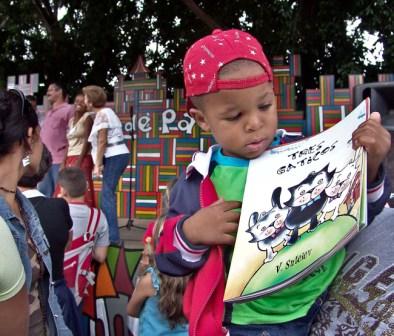Cuba’s Awesome Book Fair
HAVANA TIMES, Jan. 12.-Guess what event in Havana has the record for the highest attendance? No it’s not a championship baseball game or a timba concert, but instead the book fair that takes place each year in February.

There are several reasons why that’s the case. One is that unlike a concert or a ball game, the fair attracts people of all ages, sexes and cultural backgrounds. The second motive is that the fair isn’t just about selling books but is instead a cultural happening that combines literature with music, theater, puppets, visual arts and food stands.
Most Havana residents have their particular conception of “a day at the book fair.” For many it’s an opportunity for a family outing with the children. Others take advantage to go from one book stall to another, to meet old friends or simply to dance to the rhythm of the band playing in the evening.
The Havana segment of the 18th edition of the International Book Fair takes place this February 12-22, before moving on to the other Cuban provinces.
Book Fever
It’s truly impressive to see the hoards of people with book fever during the days of the fair. Many reserve vacation time at work to be able to take their children, often more than once. A school break for a week of the fair facilitates everyone’s participation. As of a couple few years ago some workplaces even gave a day off and provided a bus to take employees to the fair -perhaps as a way to counteract the absences or skipping out of the less disciplined.
Even people who read very little or not at all, and who during the entire year never step into a bookstore, tend to enthusiastically attend the fair and purchase books.
Since the year 2000, the book fair takes place at the San Carlos de la Cabaña Fortress, a huge 18th century construction from the times of the Spanish colony. Within its thick stone walls, interior courtyards and passageways, the fort fills with both small and large bookstands depending on the publishing house, exposition halls, a special pavilion for children, press offices, restaurants, cafeterias, kiosks and several open-air places with live music.
La Cabaña is located on the other side of the bay from Old Havana, and to get there you usually have three options: take a collective or individual taxi, ride a bus and walk the last half mile, or cross the bay in a boat and walk the steep path up to the fort.
However, during the book fair a large number of buses are put in service just for the event and run continuously from the Capital Building, a centric downtown meeting place, and the fort, moving thousands of people every hour via the Havana Bay tunnel and up and down from the fort. Once at La Cabaña, the visitors disperse throughout the installation and generally stay several hours.
Meeting Place of Authors and Readers

The fair is also a space for exchange between readers and authors. All day long, book presentations take place in several halls as well as in conferences related to literature and the publishing world in general. There’s also a nice outdoor space for poetry readings.
It’s also an opportunity to see some famous authors who come from different countries to witness the fair, which heartens anybody who feared that the book wasis going out of style. Recent fairs were attended by US authors Alice Walker, Russell Banks and historian and authorautor Howard Zinn, and Nobel Prize Laureates Wole Soyinka (Nigeria) and Gabriel Garcia Marquez (Colombia).
Each year the fair is dedicated to a country and then includes the participation of many publishers from the guest. This year, for example, the guest of honor will be Chile, the land of Pablo Neruda and Gabriela Mistral- two of the only five Latin American authors to have won the Nobel Prize for Literature.
One of the added attractions of the fair is the many side activities including an open air concert each evening at 6 p.m. Moreover, those that want to prolong the evening can stay for the 9 p.m. Cañonazo, which recreates a ceremony from the colonial times that marked the closing of the gates to the walled in city.
Outside the fortress there is also a festive atmosphere in many parts of the city, with several venues for book sales and numerous theater, dance and musical presentations linked to the fair.
For those of you planning to be in Cuba in mid-February, the book fair is a great opportunity to come closer to Latin American literature and a good cross-section of the Cuban people. For those that don’t have the opportunity, Havana Times will bring you the details of this cultural happening.
